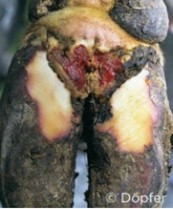How to Identify, Control & Prevent Digital Dermititis.
Digital Dermatitis, commonly referred to as hairy heel warts, poses many threats to a dairy herd in terms of health, productivity, and longevity. Hairy heel wart typically presents on the back of the heel and can look red and raw initially. The area may have raised, hair – like projections and can extend to the front of the foot. Factors such as stress leading to decreased immunity, poor micronutrient intake, wet and muddy environment, exposure to infected animals, inadequate foot bath and hoof trimming can all lead to DD (digital dermatitis) infections. Unfortunately, this is an industry – wide battle. According to a recent study by the USDA, over 70 percent of dairies in the United States had reported cases of DD. In this article we will go through key factors to prevent and treat digital dermatitis.
As you work to identify digital dermatitis cases on your herd, you may begin to recognize the different stages of the disease. The first stage, MO, is a hoof that shows no signs of DD. The remaining stages are shown below.
 |
.jpg) |
 |
 |
 |
| M1 - Early Subclinical |
M2 - Painful/ Acute Ulcer |
M3 Healing |
M4 Chronic |
M5 Chronically Recurring |
Take a walk through your facility and record any stages you find. If you notice DD in your herd, work with your vet, nutritionist, and hoof trimmer to control the outbreak. You will want to work fast, as the disease is quick to spread. Some control tactics could include topical treatment use, a change in hoof trimming and footbath practices, and the introduction of a DD specific mineral.
Like any infectious disease, prevention practices are the best form of treatment. If you have identified any of the above stages as you walk through your facility, assess your youngstock. The best way to prevent DD begins in the rearing phase. At this stage, you can work with your local Premier Cooperative nutritionist to formulate a DD specific mineral to feed. Research has shown feeding a DD mineral in the pre – calving phase decreases the incidence of DD lesions. Proper nutrition and micronutrient intake will also support healthy skin which aids in the prevention of digital dermatitis. Further prevention and control management practices include regular foot baths, hoof trims and maintaining a clean, comfortable environment. If you are planning to introduce new animals to your herd, keep an eye on biosecurity practices.
If you need help in preventing digital dermatitis through feeding a DD specific feed, reach out to your local Premier Cooperative nutritionist today to discuss the many minerals, tubs, and additives we have in stock for you.

Genny Speckman
Dairy Nutritionist



.jpg)




